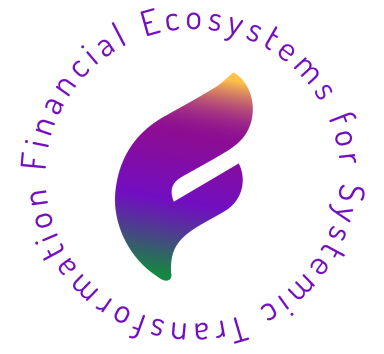The Key Technical Challenges
There are critical financial technical innovations that must be developed for systemic transformation finance.
Developing financial ecosystems for systemic transformation requires innovations of processes, tools and structures. To develop these innovations requires assertion of particular values (e.g.: long-term well-being), addressing power issues (e.g.: those determined to assert short-termism) and creating new mental and business models. A tentative list below arises from review of documents and conversations. Many initiatives are already engaged in working on one or more of the challenges and a valuable action is to bring them together to share what they are doing and develop a collaborative action plan to address the challenge.
- Aggregating Capital: The various capital sources must be assembled at sufficient scale to finance systemic transformation. This requires new mechanisms and organizations, such as we see with social stock markets.
- Blending Capital: Money exists in diverse pots that can be defined by the pots’ purpose. Beyond business investment for business development, public sector investment focused on the common good, and foundation investment focused on equality and particular issues, there is science funding for knowledge development, development banks for economic and social development, remittances for families and communities, pensions for long-term financial security and other pots. As well, there are diverse forms of capital including social, natural and intellectual. How can these be effectively blended for FST?
- Capacity Knowledge about raising and applying finance has traditionally been held in elite organizations. How can capacity be developed on a broad and community level?
- Equitability: Power in ecosystems is a big issue to move beyond the usual control position of those with money. New structures of post-colonial relationships are required.
- Financial Ecosystems: What is the range of FST ecosystem models, and how can they be evolved beginning at various points in the ecosystem? How can they be designed as powerful systems of robust connections?
- It’s Possible: Demonstrating that creating ecosystems for FST is possible, and learning how they evolve.
- Metrics: Since governments, the private sector, and foundations/development banks are all financial parties in systemic transformation, they all must develop metrics to guide their investments and development of FST ecosystems.
- New Deal Flow: New FST ecosystems require identifying going beyond traditional methods of foundation calls and venture capital searches. They also usually require combining several proposed actions for a scale that will produce systemic transformation.
- Policy: The emergence of FST ecosystems and their component parts requires changes in policy at local, national and international levels. What does this policy look like and how can it be implemented?
- Systemic: How can capital be applied in numerous initiatives to realize systemic transformation in regions/issues/industries?
- To Value Creation: The purpose of an FST ecosystem focuses on systemic transformation for value creation, rather than wealth generation. How is value creation ensured for all parties without exploiting those working for community well-being.

We need your consent to load the translations
We use a third-party service to translate the website content that may collect data about your activity. Please review the details in the privacy policy and accept the service to view the translations.

